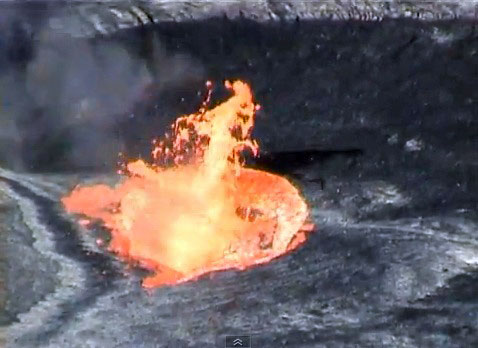What Would Happen If You Fell Into a Volcano?

In this weekly series, Life's Little Mysteries provides expert answers to challenging questions.
What would happen if you leaned a bit too far over the rim of a volcano and fell in? You would die, of course — but how?
The question has garnered more scientific investigation than you might expect. As reported in December, lava's high density and resistance to flow suggest a person would smack onto the surface of a lava pit rather than sinking into it.
So, instead of dying like Gollum, who dove into a bubbling volcano in the book and film "Lord of the Rings: Return of the King," a simple physics analysis indicates you would stay buoyed on top. This wouldn't save you from a gruesome fate, however: Resting on a bed of molten rock four times hotter than the broiler in an oven, you'd quickly burst into flames and burn to death.
But a newly surfaced video shows that a fallen person might, in fact, be able to penetrate the surface of a lava pit via inroads made by the gases given off by his or her burning flesh. [Smart Answers to Crazy Hypothetical Questions]
In 2002, the Germany-based volcano researcher Richard Roscoe filmed a 66 pound (30 kilogram) bag of leftover food and other organic matter being thrown into the lava lake of Ethiopia's Erta Ale Volcano. The bag of waste fell 260 feet (80 meters) before striking the surface — and, as seen in the video, it ended up making a dent. As the bag burned, it caused violent outbursts of lava in an effect known as fountaining.
"It is frequently discussed whether it is possible to sink in lava. Due to its high density, a person would generally be expected to remain on the surface," Roscoe wrote in a video description on YouTube, where he recently posted the footage. "Indeed it is possible to briefly walk on certain types of lava if professional heat-protective clothing is worn (do not try yourself). However, the video shows that falling from a height, a person would be able to penetrate the crust of the lake and submerge in it."
Get the world’s most fascinating discoveries delivered straight to your inbox.
Roscoe suggested the lava's fountaining activity may have been induced by steam produced by the organic matter as it burned.
Follow Natalie Wolchover on Twitter @nattyover. Follow Life's Little Mysteries on Twitter @llmysteries. We're also on Facebook & Google+.
Natalie Wolchover was a staff writer for Live Science from 2010 to 2012 and is currently a senior physics writer and editor for Quanta Magazine. She holds a bachelor's degree in physics from Tufts University and has studied physics at the University of California, Berkeley. Along with the staff of Quanta, Wolchover won the 2022 Pulitzer Prize for explanatory writing for her work on the building of the James Webb Space Telescope. Her work has also appeared in the The Best American Science and Nature Writing and The Best Writing on Mathematics, Nature, The New Yorker and Popular Science. She was the 2016 winner of the Evert Clark/Seth Payne Award, an annual prize for young science journalists, as well as the winner of the 2017 Science Communication Award for the American Institute of Physics.




